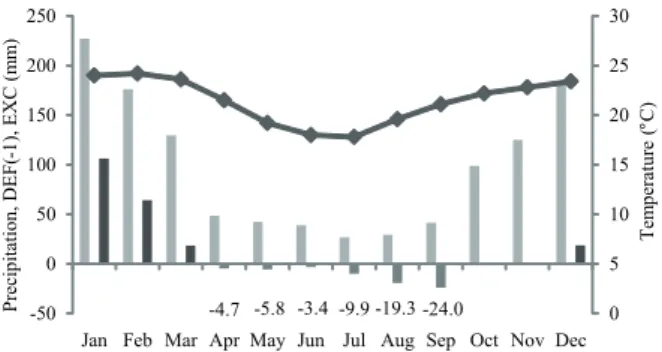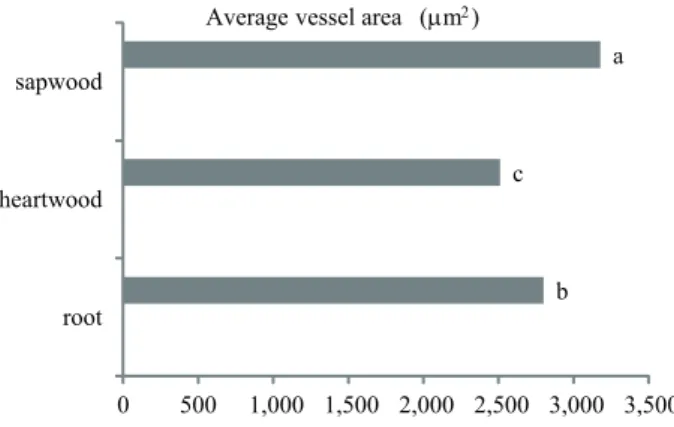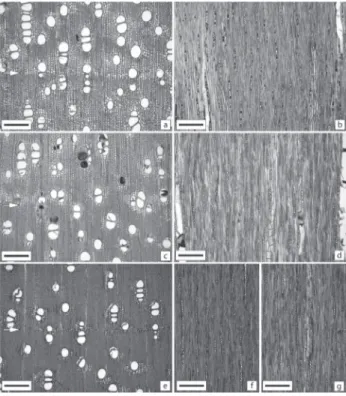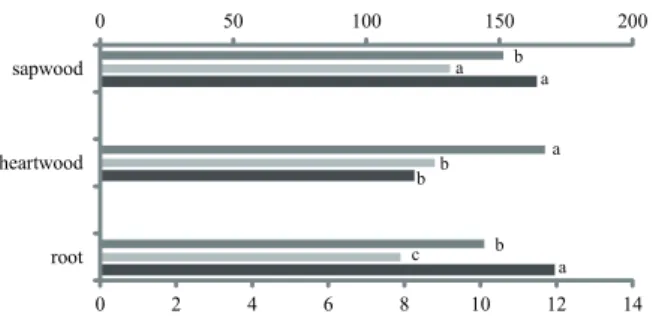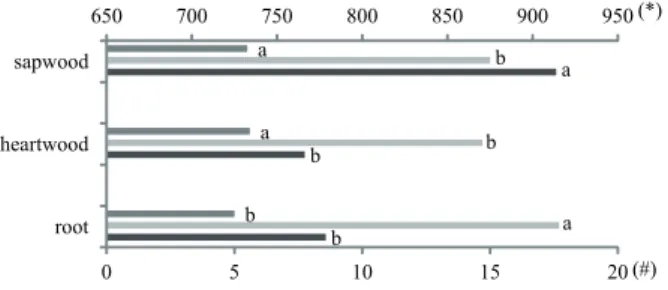Differences in anatomy and potential hydraulic conductivity between
root and stem of
Caesalpinia echinata
Lam. (Fabaceae)
Eduardo Luiz Longui1,3, Diego Romeiro2 and Edenise Segala Alves2
Received: 13.08.2012; accepted: 27.12.2012
ABSTRACT - (Differences in anatomy and potential hydraulic conductivity between root and stem of Caesalpinia echinata Lam. (Fabaceae)). We investigated the root and stem wood of Caesalpinia echinata Lam. to test the hypothesis that there are anatomical and water conductivity differences between both organs. Three trees about 20 years old were sampled in the Reserva Biológica de Mogi Guaçu, São Paulo State, Brazil. We observed quantitative anatomical differences between the root, heartwood, and sapwood of C. echinata that result in differences in water conductivity. The sapwood has higher potential hydraulic conductivity than the heartwood (when functional), and root. The higher proportion of axial parenchyma in the root could contribute to the storage of starch and water in unfavorable periods, which is important to the osmotic regulation of the daily water deficits, avoiding cavitation. The stem of C. echinata probably has a higher mechanical strength than the root due to its fibers with thicker wall.
Key words: heartwood, pau-brasil, sapwood, water transport, wood anatomy
RESUMO - (Diferenças na anatomia e condutividade hidráulica potencial entre raiz e caule de Caesalpinia echinata Lam. (Fabaceae)). Investigamos o lenho da raiz e caule de Caesalpinia echinata Lam. para testar a hipótese de que há diferenças na anatomia e condutividade hidráulica nesses órgãos. Três árvores com cerca de 20 anos de idade foram coletadas na Reserva Biológica de Mogi Guaçu, SP, Brasil. Observamos diferenças na estrutura anatômica da raiz, cerne e alburno de C. echinata que podem resultar em diferenças na condutividade hidráulica. O alburno apresentou maior condutividade hidráulica quando comparado ao cerne, quando esse estava ativo, e raiz. A raiz apresenta maior proporção de parênquima axial, que pode contribuir no armazenamento de amido e água em períodos desfavoráveis e contribuir na regulação osmótica no déficit de água diário, evitando a cavitação. O caule de C. echinata provavelmente tem maior resistência mecânica do que a raiz devido à presença de fibras com paredes mais espessas.
Palavras-chave: alburno, anatomia da madeira, cerne, pau brasil, transporte de água
1. Instituto Florestal, Caixa Postal 1322, 02377-000 São Paulo, SP, Brasil
2. Instituto de Botânica, Núcleo de Pesquisa em Anatomia, Caixa Postal 3005, 01031-970 São Paulo SP, Brasil 3. Corresponding author: edulongui@gmail.com
Introduction
The structure of the wood from the root and stem of arboreous species is important because it indicates the adaptations of the tree to the environment. Comparing both organs, the roots are not normally subjected to low hydraulic potential, and also do not require mechanical support, such as the stem, but they are compressed by the soil surrounding them. Besides, they provide support to the plant, and storage more carbohydrates than the stem (Baas et al. 2004).
Structural differences between root and stem woods have been reported for some species and they are related to the different functions and environmental
pressures that both organs are submitted (Machado
et al. 2007). Consequently, the comparative study of
the root and stem wood can expand the knowledge about water transport and mechanical strength in tree species. However, relatively few studies have been developed with both organs because of the difficulty in collecting the root samples.
Considering the trade-off between conductivity efficiency and mechanical strength (Baas et al. 2004),
et al. 2004). Therefore, based on the wood structure
it is possible to predict and understand the variations between hydraulic conductivity and resistance of the wood.
In this study we investigated the root and stem wood of Caesalpinia echinata Lam., Fabaceae,
endemic species from the Atlantic forest that occurs in Brazil from Rio Grande do Norte State - NE to Rio de Janeiro State - SE (Lewis 2012). The structure and properties of the stem wood of C. echinata is
well known (Mainieri 1960, Angyalossy et al. 2005,
Alves et al. 2008, Longui et al. 2010), but we have
not found any studies about its root anatomy. We hypothesized that there are anatomical and hydraulic conductivity differences between root and stem of
Caesalpinia echinata wood. Therefore, our objective
was to compare the wood of the stem (heartwood and sapwood) and root to test this hypothesis.
Material and methods
Discs of the root and stem wood were sampled from three adult trees, about 20 years old in the Reserva Biológica de Mogi Guaçu (RBMG) situated on São Paulo State, Brazil (22º15"16'S and 47º08"12'W). The climate characterization of the area is shown in Figure 1. Root discs with diameter of 4.0-6.5 cm were sampled at a depth of 30 cm below the soil surface. Discs of the stem with diameter of 15-18 cm were sampled at breast height (1.30 m). Root and stem samples of the three specimens are deposited in the Wood Collection (SPw 1967, 1968, 1970) of the Instituto de Botânica, São Paulo State, Brazil. In the roots we did not observe differences between heartwood and sapwood, so we evaluated the conductive region functionally similar to the sapwood of the stem. In the stem the distinction between sapwood and heartwood was clear and we analyzed both separately.
Samples of 1.5 cm³ were cut from each sample. The blocks were softened in boiling water and glycerin (4:1), and 12-18-µm-thick sections were prepared using a sliding microtome Leica SM 2000 R. The transverse, tangential and radial sections were bleached with sodium hypochlorite (60%), washed in water, double-stained with safranin and astra blue (1:9) (Bukatsch 1972 apud Kraus & Arduin 1997) and
permanently mounted in Permount™. Macerations were prepared according to the modified Franklin method (Berlyn & Miksche 1976). The dissociated cells were stained with aqueous safranin and mounted in glycerin (50%). For scanning electron microscopy analyses samples were cut in blocks of 2-3 mm
-4.7 -5.8 -3.4 -9.9 -19.3 -24.0 0 5 10 15 20 25 30 -50 0 50 100 150 200 250
Jan Feb Mar Apr May Jun Jul Aug Sep Oct Nov Dec
T em p er at u re ( ° C) P re cip it at io n , DE F (-1 ), E XC (m m )
Figure 1. Average monthly sum of precipitation, water deficit DEF (-1), water surplus (EXC), and mean temperature (line) at the Mogi Guaçu city, São Paulo State, Brazil - 1961-1990 (CEPAGRI, 2012). Precipitation, DEF (-1), EXC, ● Temperature.
thickness, dried, sputter-coated with gold (Bal-Tec CPD 030) and imaged using a Philips XL 20 SEM.
Wood descriptions and measurements followed the IAWA Committee (1989) recommendations. Quantitative data are based on 25 individual counts. The vessel diameter, vessel frequency, vessel element length, intervessel pits and vessel-ray pits diameter were measured. We also measured the height and width of the rays, ray frequency and the length, diameter and wall thickness of the fibers. The average vessel area was determined on transverse sections in 25 squares of 1 mm2 each, distributed among the sections of each sample with using an Olympus BX41 microscope equipped with image capture software Image-Pro Plus 6.1, which determined automatically the vessel area and then the average area was calculated.
The vessel diameter was calculated in areas with 5 mm2. With the values, transformations were performed at diameters for the hydraulic diameter (Dh) in accordance with the following formula described by McCulloh (2010).
Dh = (∑d4/n)1/4 where d is the diameter of each
conductor.
Then, with hydraulic diameter values, the potential hydraulic conductivity (Kp) was determined using the formula:
Kp = (πρ/128ηA)[Dh4] where i = 1 or n vessels per
area, A: area, ρ: water density (998.2 kg m-3 at 20 °C
and η is the viscosity of water (1.002 × 10-9 MPas-1
at 20 °C), Kp, kg m-1 MPa-1 s-1 (modified by Fan et al. 2012).
Results
The vessel diameter was wider in the sapwood and narrower in heartwood and root. There were no differences in the vessel frequency among root, heartwood and sapwood. The vessel element length was longer in the sapwood and shorter in heartwood (figure 2). The average vessel area was higher in the sapwood and lower in heartwood and both were different from the root (figure 3). The sapwood had higher potential hydraulic conductivity than heartwood, when the latter was functional, and root (figure 4). Some vessels of the heartwood were filled with extractives (figure 5c), which were not observed in the root and sapwood (figure 5a and b, respectively). The largest intervessel pits occurred in the root and they were higher than those of the stem, while vessel-ray pits did not differ among the root, sapwood and heartwood (figure 6).
The rays were statistically larger in the heartwood, the frequency was higher in the sapwood and lower in the root and longer in the root and sapwood (figures 5b, d, f and g and figure 7).
The fiber wall thickness was bigger in stems, with no difference between heartwood and sapwood. The diameter was bigger in root and smaller in the heartwood and sapwood, which did not differ. The fiber length did not differ among the root and heartwood, and was longer in the sapwood (figure 8).
Root and stem did not show marked qualitative differences. Both organs present growth layers delimited by flattened and thickened fibers (figure 5a, c, e), vessels mostly diffuse, solitary and in multiples of two or more; the perforation plates are simple, intervessel pits are alternate with small size and vessel-ray pits are similar to intervessel pits in shape, both are vestured. In heartwood, vessels present
Figure 2. Variations in vessel features among the root and stem (heartwood and sapwood). ANOVA results: vessel diameter F = 12.157 P < 0.001, vessel frequency F = 1.021 P = 0.361, vessel element length F = 11.754 P < 0.001. Distinct letters differ statistically at P < 0.05 with the Tukey test, n = 150. Vessel diameter (#) (µm), Vessel frequency (#) (n.mm-2), Vessel element lengh (*) (µm).
b c
a
0 500 1,000 1,500 2,000 2,500 3,000 3,500 root
heartwood sapwood
Average vessel area (µm2)
Figure 3. Variations in average vessel area in 1 mm2 between root and stem (heartwood and sapwood). ANOVA results: F = 3.559 P = 0.031. Distinct letters differ statistically at P < 0.05 with the Tukey test, n = 150.
deposits (extractives). Root and stem have libriform fibers with very thick-walled. Both organs have axial parenchyma vasicentric, apparently most abundant in the root and aliform with short confluences (figure 5a, c and e) that also has higher amount of starch grains. Rays are 2-seriate (figure 5b, d, f and g) and homogeneous with procumbent cells; in the two organs the rays are regularly or irregularly storied (figure 5f and g). Crystals were observed in the two organs, but in heartwood they were in the axial and radial parenchyma while in the sapwood and root, prismatic crystals were mostly in the axial parenchyma.
Discussion
Variations in the vessel features, especially in frequency and diameter are strongly related to the water transport in plants (Hacke et al. 2005).
However, in Caesalpinia echinata Lam. we did
not find variations in the vessel frequency among root, heartwood and sapwood, suggesting that is the vessel diameter, which strongly influences the water transport in this species. In trees and shrubs some authors, i.e. Ewers et al. (1997), observed that root
usually has wider vessels than stem. However, in some cases, this trend was not totally confirmed, and it was noted that the vessels dimensions are related to the functional adaptations (Machado et al. 2007, Goulart
& Marcati 2008).
According to Zimmermann & Potter (1982), xylem pressures and risks of embolism are higher at the top than at the base of the tree; consequently the vessels at the top need to be comparatively safer. Besides, roots vessels can be more efficient than safer. It can explain why vessel diameter tends to
a a a
b b
a
b c
a
220 240 260 280 300
0 10 20 30 40 50
root heartwood sapwood
b b
a
0 0.00002 0.00004 0.00006
root heartwood sapwood
Potential hydraulic conductivity Kp (Kg m-1s-1MPa-1)
Figure 4. Variations in potential hydraulic conductivity between root and stem (heartwood-when it was functional-and sapwood). ANOVA results: F = 11.036 P < 0.001. Distinct letters differ statistically at P < 0.05 with the Tukey test, n = 150.
increase from the top to the base of a tree. However,
in C. echinata we found narrower vessels in the root
and heartwood than in sapwood, so this trend cannot be applied for this species. For instance, Machado
et al. (2007) comparing species of Styrax observed that
vessel diameter was wider in the stem in the species from the forest, while vessel diameter was wider in the root from Cerrado species. These results confirm that strategies involving wood safety and efficiency depend on the environmental conditions.
Aloni (2001) proposes the six-point hypothesis for explain the vessel diameter variation along the plant axis. The author reported that higher auxin levels near the young leaves induce narrow vessels because of their rapid differentiation, allowing only limited time for cell growth. Contrariwise, low auxin concentrations further down result in slow differentiation, which permits more cell expansion before secondary wall deposition, and therefore results in wide vessels. Aloni also describes that high auxin concentrations induce greater vessel frequency, while low concentrations (further down, towards the roots) lower frequency. Therefore, vessel density decreases from leaves to roots.
In the present study we did not observe the pattern described by Aloni (2001), possible explanations would be that C. echinata not exactly follow this
pattern or the sapwood and root samples have not been formed in the same period and therefore the differences between sapwood and root deriving from radial variation.
In C. echinata we found longer vessel elements in the sapwood than in the root. Carlquist (2001) mentions that the variations in the vessel element length are not randomly distribute, but are related to ecological factors. Comparing dicotyledons from drier with their relatives from more humid habitats,
Figure 5. Transverse and tangential sections of the wood of Caesalpinia echinata Lam. Figures a, c, e. transverse section of root, heartwood and sapwood, respectively. Note the highest vessel diameter in the sapwood and lowest in heartwood; in the latter some vessels are filled with extractives. Arrows indicate growth layers. Figures b, d. tangential sections of root and heartwood, respectively. Figure f, g. sapwood with irregularly storied (f) and storied rays (g). Scale bars = 200 µm.
the author observed shorter elements in the former, thus in environmental conditions where safety is more important than efficiency, the vessel elements can be shorter. However, conductive efficiency and safety are directly related with the vessel length (Zimmermann 1983), and the vessel element length has a secondary importance. It is reinforced by Wheeler et al. (2007)
who inform that the functional advantages of shorter or longer vessel elements are not well established and they reflect the fusiform initial lengths.
Thus, besides diameter and frequency, other vessel features should be investigated for a better understanding of water transport in roots and stems. In our study with C. echinata we employed the potential
hydraulic conductivity formula proposed Fan et al.
(2012), and also established the average vessel area. In C. echinata, the results related to vessel diameter,
Figure 6. Variations in pit dimensions among the root and stem (heartwood and sapwood). ANOVA results: intervessel pits F = 7.274 P < 0.001, vessel-ray pits F = 0.357 P = 0.700. Distinct letters differ statistically at P < 0.05 with the Tukey test, n = 150. Vessel-ray pits (µm), Intervessel pits (µm).
a b
b
a a a
4.6 4.8 5.0 5.2 5.4 5.6 5.8 6.0
root heartwood sapwood
affirms that in diffuse-porous hardwoods the specific conductivity is higher in the mature than in the juvenile wood, due to the radial increase in vessel diameter toward to bark. When we compared only heartwood and root, we found greater potential to conduction in the latter.
Considering that the root samples were collected near to the bark in the conductive portion, we estimate that this tissue has been formed approximately in the same period of sapwood formation. In these terms, we suggest that the stem (sapwood) has a slightly higher potential conduction than the root at same age.
Intervessel pits also influence the stem-root hydraulic conductivity Caesalpinia echinata has
vestured pits which contribute to hydraulic safety, because vestures limit the degree of pit membrane can be deflected from center of the pit cavity (Evert & Eichhorn 2006), limit the increase of membrane porosity and reduce the probability of air seeding (Choat et al. 2008). In C. echinata vestures hinder the
clear delimitation of the pit pore area, so it was not measured. However, we speculate that the occurrence of larger diameter pits in roots than in the stem may compensate the lower conductivity of the roots, as discussed before. Thus, the conductivity would be similar in both organs.
The ray cells have an important role in storage and in radial transport of substances between the xylem and the phloem. According to Goulart & Marcati (2008), plants from poor soil / seasonal environment and with superficial roots have wide rays, capable to provide nutrients to the plant during dry periods. In addition, in the root wood, the rays are wider and have greater number of cells (Metcalfe & Chalk 1983). Wider and more frequent rays lead to a higher capacity of storage, but also lead to a reduction of the mechanical resistance of the wood. This fact
Figure 7. Variations in ray features between root and stem (heartwood and sapwood). ANOVA results: ray width F = 29.917 P < 0.001, ray frequency F = 4.424 P = 0.013, ray height F = 25.168 P < 0.001. Distinct letters differ statistically at P < 0.05 with the Tukey test, n = 150. Ray width (#) (µm), Ray height (*) (µm),
Ray height (*) (µm).
c b
a
b a b
a b
a
0 50 100 150 200
0 2 4 6 8 10 12 14
root heartwood sapwood
is not an issue, since the root wood appears to be exposed to less mechanical stress (Hsu et al. 2006).
In C. echinata we did not observe a clear tendency
about the dimensions of rays in root and stem wood, but rays were more frequent in the stem.
The axial and radial parenchyma has an important role in the storage of starch and water. In C. echinata,
even without making measurements, we observed a higher proportion of axial parenchyma in the root than in the stem. Brodersen et al. (2010) in study
with grapevine proposes an embolism repair model: "embolisms trigger surrounding cells to secrete solutes into the vessel, establishing an osmotic gradient drawing water from the surrounding fibers and parenchyma cells into the vessel. Water droplets grow until they coalesce, spanning the width of the vessel. If the refilling vessel is in direct contact with another filled vessel under tension then the water may drain to the neighbor, causing the vessel to empty. Vessels that receive sufficient water to overcome loss to a neighbor successfully refill, compressing the remaining gas until it dissolves into solution or escapes into surrounding hydrophobic microchannels in the vessel wall".
According to Borchert & Pockman (2005) in stem-succulent and other drought-avoiding species xylem vessels are surrounded by extensive parenchyma that provides intracellular water storage. Scholz et al.
(2007) reported that in Cerrado plants the water stored in sapwood is important to the osmotic regulation of the daily water deficits, avoiding cavitation. So, we believe that in C. echinata from RBMG, where a water deficit
(67.1 mm) is accumulated during the dry season (April to October), parenchyma cells, especially in the roots, have an important role in the regulation of water transport.
Atlantic Forest, and used for the manufacture of violin bows, found lower vessel frequency than those we observed in plants collected in the Cerrado, where the soils are acid, dystrophic, poor in available nutrients (Haridasan 2008).
Conclusions
We concluded that there are quantitative anatomical differences in vessel diameter between the root, heartwood and sapwood of Caesalpinia echinata Lam. that result in differences in water
conductivity. The sapwood has higher potential hydraulic conductivity than heartwood, when it was functional, and root. In addition, the higher proportion of axial parenchyma in the root should contribute to the storage of starch and water in unfavorable periods and important to the osmotic regulation of the daily water deficits, avoiding cavitation. The stem of
C. echinata probably has a higher mechanical strength
than the root due to its fibers with thicker wall.
Acknowledgements
We wish to thank Dr. Agnes E. Luchi and FAPESP (Proc. 00/06422-4). E.S. Alves also thanks CNPq for the research fellow (Proc. 303132/2009-4).
Literature cited
Aloni, R. 2001. Foliar and axial aspects of vascular
differentiation: Hypotheses and evidence. Journal Plant Growth Regulation 20: 22-34.
Alves, E.S., Longui, E.L. & Amano, E. 2008. Pernambuco
wood (Caesalpinia echinata) used in the manufacture of bows for string instruments. IAWA Journal 29: 323-335.
Angyalossy, V., Amano, E. & Alves, E.S. 2005. Madeiras
utilizadas na fabricação de arcos para instrumentos de corda: aspectos anatômicos. Acta Botanica Brasilica 19: 819-834.
Baas, P., Ewers, F.W., Davis, S.D. & Wheeler, E.A.
2004. Evolution of xylem physiology. In: I. Poole & A. Hemsley (eds.). Evolution of Plant Physiology. Elsevier Academic Press (Linnaean Society Symposium Series), London, pp. 273-295.
Berlyn, G.P. & Miksche, J.P. 1976. Botanical microtechnique and cytochemistry. The Iowa University Press, Iowa.
Borchert R. & Pockman W.T. 2005. Water storage
capacitance and xylem tension in isolated branches of temperate and tropical trees. Tree Physiology 25: 457-466.
Figure 8. Variations in fiber features among the root and stem (heartwood and sapwood). ANOVA results: fiber length F = 22.751 P < 0.001, fiber diameter F = 27.870 P < 0.001, fiber wall thickness F = 6.582 P = 0.002. Distinct letters differ statistically at P < 0.05 with the Tukey test, n = 150. Fiber wall thickness (#) (µm),
Fiber diameter (#) (µm), Fiber length (*) (µm).
a b
b
b a a
b b
a
650 700 750 800 850 900 950
0 5 10 15 20
root heartwood sapwood
(*)
(#) consequently, growth zones in the wood of tropical trees. In RBMG occurs a water deficit during six months (April to September), a water surplus during four months (December to March) and, during two months (October-November), the rainfall is equal to the evapotranspiration. These conditions lead to the formation of growth rings in C. echinata marked by flattened and
thickned fibers, and present in both root and stem. Variations in the anatomical features interfere in the wood properties according to the tradeoff: water transport × mechanical strength mentioned by Baas
et al. (2004). The presence of fibers with thicker walls
in the stem suggests that this organ is stronger than the root. However, the pressure of soil surrounding the roots contributes to them are not pulled out due to passive loads (own weight) or active loads, such the wind (Niklas, 1992). Some authors, such as Gasson (1987) in Quercus rubor and Fagus sylvatica and
Goulart & Marcati (2008) in Lippia salviifolia also
reported fibers with thicker walls in the stem than in the roots as observed in C. echinata. Moreover, C. echinata has longer fibers in the sapwood in
comparing with root wood and heartwood, and it is related to the maturation of the cambium and production of longer cells toward to the bark. This variation is widely discussed by Lachenbruch et al.
(2011) who reported that is most likely biased by the higher number of studies on softwoods than hardwoods, although one of the main differences between the tissues located near the pith and those near the bark is that the former present shorter cells with smaller diameter and thinner walls. We did not find studies that compare samples of root and stem of C. echinata from the Atlantic Forest, where
the species occurs naturally (Rocha & Simabukuro 2008). However, Alves et al. (2008), analyzing the
Brodersen C.R., McElrone A.J., Choat B., Matthews M.A. & Shackel K.A. 2010. The dynamics of embolism repair
in xylem: in vivo visualizations using high resolution computed tomography. Plant Physiology 154: 1088-1095.
Carlquist, S. 2001. Comparative wood anatomy:
systematic, ecological and evolutionary aspects of dicotyledon wood. 2 ed. Springer Verlag, Berlin.
CEPAGRI (Centro de pesquisas meteorológicas e
climáticas aplicadas à agricultura). 2012. Clima dos Municípios Paulistas. http://www.cpa.unicamp.br/ outras-informacoes/clima-dos-municipios-paulistas. html (access in 10.11.2012).
Choat, B., Cobb, A.R. & Jansen, S. 2008. Structure and
function of bordered pits: new discoveries and impacts on whole-plant hydraulic function. New Phytologist 177: 608-626.
Evert, R.F. & Eichhorn, S.E. 2006. Esau's plant anatomy.
Meristems, cells, and tissues of the plant body - Their structure, function, and development. 3rd edition. John
Wiley & Sons Inc., New Jersey.
Ewers, F.W., Carlton, M.R., Fisher, J.B., Kolb, K.J. &
Tyree, M.T. 1997. Vessel diameters in roots versus
stems of tropical lianas and other growth forms. IAWA Journal 18: 261-279.
Fan, Z.X., Zhang, S.B., Hao, G.Y., Ferry Slik, J.W. & Cao, K.F. 2012. Hydraulic conductivity traits predict growth
rates and adult stature of 40 Asian tropical tree species better than wood density. Journal of Ecology 100: 732-741.
Gasson, P. 1987. Some implications of anatomical
variations in the wood of pedunculate oak (Quercus robur L.) including comparisons with comoron beech
(Fagus sylvatica L.). IAWA Bulletin n.s. 8: 149-166.
Goulart, S.L & Marcati, C.R. 2008. Anatomia comparada
do lenho em raiz e caule de Lippia salviifolia Cham. (Verbenaceae). Revista Brasileira de Botânica 31: 263-275.
Hacke, U.G., Sperry J.S. & Pittermann J. 2005. Efficiency
versus safety tradeoffs for water conduction in angiosperm vessels versus gymnosperm tracheids. In: N.M. Holbrook & M.A. Zwienniecki (eds.). Vascular transport in plants. Elsevier Incorporated, Amsterdam, pp. 333-354.
Haridasan, M. 2008. Nutritional adaptations of native
plants of the cerrado biome in acid soils. Brazilian Journal of Plant Physiology 20: 183-195.
Hsu L.C.Y., Walker J.C.F., Butterfield B.G. & Jackson S.L. 2006. Compression wood does not form in the roots
of Pinus radiate. IAWA Journal 27: 45-54.
IAWA Committe. 1989. IAWA list of microscopic features for
hardwood identification. IAWA Bulletin n.s. 10: 219-332.
Kraus, J.E. & Arduin, M. 1997. Manual básico de métodos
em morfologia vegetal. Editora Universidade Rural, Rio de Janeiro.
Lachenbruch, B., Moore, J. & Evans, R. 2011.
Radial variation in wood structure and function in woody plants, and hypotheses for its occurrence. In:
F.C. Meinzer, B. Lachenbruch, & T.E. Dawson (eds.). Size and age-related changes in tree structure and function, Springer, Dordrecht.pp. 121-164.
Lewis, G.P. 2012. Caesalpinia. In: R.C. Forzza, A. Costa, B.M.T. Walter, J.R. Pirani, M.P. Morim, L.P. Queiroz, G. Martinelli, A.L. Peixoto, M.A.N. Coelho, J.F.A. Baumgratz, J.R. Stehmann, L.G. Lohmann, M. Hopkins. Lista de Espécies da Flora do Brasil. Jardim Botânico do Rio de Janeiro, Rio de Janeiro. http://floradobrasil. jbrj.gov.br/2010/FB022840 (access in 17.05.2012).
Longui, E.L., Lombardi, D.R. & Alves, E.S. 2010.
Potential Brazilian wood species for bows of string instruments. Holzforschung 64: 511-520.
Machado, S.R., Rodella, R.A, Angyalossy, V. &. Marcati, C.R. 2007. Structural variations in root and stemwood of
Styrax (Styracaceae) from Brazilian forest and cerrado. IAWA Journal 28: 173-188.
Mainieri, C. 1960. Estudo macro e microscópico de
madeiras conhecidas por pau-brasil. Publicação 612 Instituto de Pesquisas Tecnológicas, São Paulo.
Metcalfe, C.R. & Chalk, L. 1983. Anatomy of the
dicotyledons: wood structure and conclusion of the general introduction. 2 ed. Oxford University Press, New York, v.2.
McCulloh, K., Sperry, J.S., Lachenbruch, B., Meinzer,
F.C., Reich, P.B. & Voelker, S. 2010. Moving water
well: comparing hydraulic efficiency in twigs and trunks of coniferous, ring-porous, and diffuse porous saplings from temperate and tropical forests. New Phytologist 186: 439-450.
Niklas, K.J. 1992. Plant biomechanics: an engineering
approach to plant form and function. University of Chicago Press, Chicago.
Rocha, Y.T. & Simabukuro, E.A. 2008. Estratégias de
conservação in situ e ex situ do pau-brasil. In: R.C.L.F.
Ribeiro, C.J. Barbedo, E.S. Alves, M. Domingos & M.R. Braga (orgs.). Pau-brasil, da semente à madeira: conhecer para conservar. Instituto de Botânica, São Paulo, pp. 102-113.
Scholz, F.G., Bucci, S.J., Goldstein. G., Meinzer,
F.C, Franco, A.C. & Miralles-Wilhelm, F. 2007.
Biophysical properties and functional significance of stem water storage tissues in Neotropical savanna. Plant Cell Environment 30: 236-248.
Wheeler E. A., Baas P. & Rodgers S. 2007. Variations
in dicot wood anatomy: A global analysis based on the InsideWood database. IAWA Journal 28: 229-258.
Worbes, M. 1995. How to measure growth dynamics in
tropical trees - a review. IAWA Journal 16: 337-351.
Zimmermann M.H. 1978. Hydraulic architecture of
some diffuse-porous trees. Canadian Journal of Botany 56: 2286-2295.
Zimmermann, M.H. 1983. Xylem structure and the ascent
of sap. Springer-Verlag, New York.
Zimmermann, M.H. & Potter, D. 1982. Vessel-length
